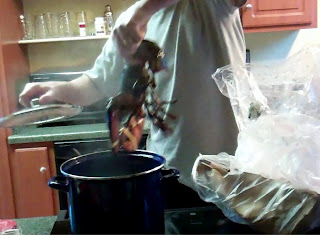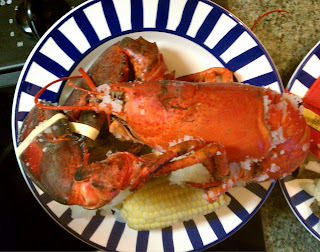The first time I ever fell asleep in class was during high
school economics my senior year. I’d
like to say I fell asleep because I was staying up late working or even going
out with my friends (I won’t even try to say it was because of studying). It was also the first time I ever earned a D
in a class. When my parents asked about
the grade, my response was the same as most students’ whose grades were
slipping, “The teacher is boring.”
Of course, that earned me narrowed eyes and a big, “So what?”
I loved school and learning.
“Dull” was one thing – a teacher who lacked a dynamic personality - but
that had never stopped me from learning before.
Then I realized “boring” meant that I couldn’t relate my life to
anything that the teacher was describing.
I can still hear the teacher saying, “Guns and butter….”
How (or why) would
butter be made in a gun factory or vice-versa? And wouldn’t
there be metal shards in the first batch of butter? That would be dangerous. How long did it take to clean the equipment
to make it safe for making butter? Were
the first batch of guns slippery?
And then everything would fade to black and the unicorns and
rainbows would appear and all was right once more.
“How can you not
understand economics?” my dad asked.
I had run two “businesses” prior to my senior year – first
the quail raising fiasco with my neighbor throughout middle school and in my
sophomore year when I served as vice president of marketing for Junior
Achievement (where we actually decided on a product, made it, and sold it, not
just filling out a workbook, which is what happens today). I knew about cost effectiveness, the
difference between gross and net, the importance of pleasing stockholders as
well as keeping worker morale high (all members of JA were paid) among other
concepts, although without the terminology.
But there was a simpler way for the teacher to relate economics
to all students: Halloween booty.
While costumes were important, as every child knows, a
significant part of Halloween is about candy, not just quantity, but also
quality.
It starts with market
research. This is done the day
before Halloween, an informal survey among fellow students. With a neighborhood school, everyone knew
where their classmates lived and most of us were within walking distance. “What kind of Halloween are you guys giving
out?” Chocolate earned high marks, taffy,
low. Pixie sticks and Smarties were flexible depending on one’s taste. A sufficient number of chocolates warranted
adding that street to the route. There
was also some research done on the fly as one group left a house when another
approached. “What are they giving
out?” “BUTTERFINGERS!” Yes! Or (sigh) “Neccos.” Ugh. Pass.
Business Plan: Having a plan was key. How long would trick-or-treating last? What routes would maximize quantity and
quality? What size of bag would allow
for a good take, but not look too greedy not to mention be comfortable to carry
with its weighted load. Plastic pumpkins
cut up hands, and we wanted payment to be as painless as possible.
Sales: For safety (and fun), no one went
trick-or-treating alone. But the number
in the group, along with the type of costume needed to be considered. A large disorganized group allowed for
occasional double dipping, but could also result in team members being
overlooked. If costumes were too
threatening, the homeowner would want to be done with the transaction
quicker. Small talk or gimmicks (singing
or other performance) were worthwhile at places with high value candy.
The trick-or-treating business did not end once we returned
back home.
Gross Profit: Candy was counted and sorted. Any open candy was tossed, naturally.
Then negotiations began.
Supply and Demand: Fortunately, my sister and I had differing
tastes in candy. She preferred tart and
powdery whereas I preferred chocolate with something (Butterfingers, Krackles,
$100,000 Bars) and caramel (Milk Duds, Sugar Daddies, and caramel squares).
Some items were an equal exchange - Bit
O’Honey for Pixi Stix. And then there
were the disposables – Specials, Neccos, and 3 Musketeers. Depending on the trend, there might be more
tart than chocolate, potentially giving my sister the advantage.
Pricing: While tart wasn’t my favorite flavor, was I
willing to sacrifice quantity for quality?
Mid-value candy (butterscotch, Jolly Ranchers, plain milk chocolate and
lollypops) gave a little more flexibility.
Full size candy bars and Dip Sticks were gold.
Taxes: As with the monetary world, a portion of the
Halloween booty went to the governing forces.
My dad didn’t have a sweet tooth, but my mother had some favorites. At the time, since neither my sister nor I
liked dark chocolate, all the Specials would go to my mother. She could have the 3 Musketeers as well. However, sometimes those didn’t suffice and
taxes were raised. My mother would ask
for our Snickers. My sister didn’t mind,
but I liked caramel, so it became an issue of negotiating Mr. Goodbars and Baby
Ruths, again decreasing quantity, but increasing quality.
Budgeting: My mother rarely bought candy and when she
did, it was usually a box of See’s. My
sister and I were allowed to keep our candy, eating as much or as little as we
pleased whenever we liked (although, there was The Great Disaster when our
dachshund found my stash and devoured all but a single Tootsie Roll that bore a
piercing the diameter of his tooth). It
was considered a high achievement to still have candy when Thanksgiving
arrived, and it never tasted sweeter than when the other sibling had squandered
their portion. Disposable Goods: My sister and I got so good at “budgeting,” that some candy turned sticky and gooey before we could finish it. We learned which candies kept (bubble gum) and which went “bad”(hard candy) and organized our consumption to accommodate expiration dates.
I took economics again in college, dreading the moment. However, my professor used a variety of illustrations, including a Broadway musical song, to explain terms and concepts. I didn’t fall asleep and surprisingly, I had the highest grade in the class. Sweet.





.jpg)

